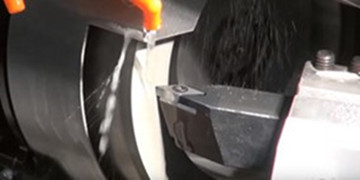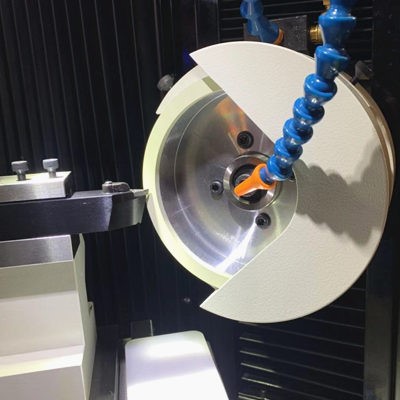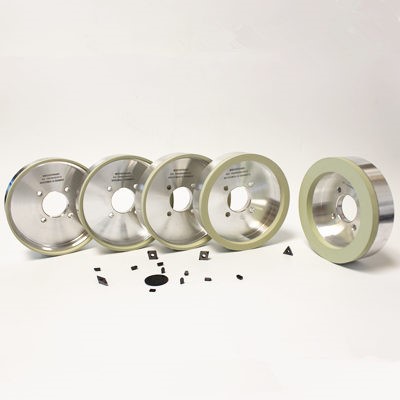Selection and Characteristics of PCD and PCBN Cutting Tools
Selection of sharpening process
One of the purposes of cutting tool sharpening is to obtain cost-effective cutting edge quality, and the key to quality is the choice of the size of the sharpening wheel. The finer the grinding wheel particle size, the smaller the cutting edge chipping, and the lower the grinding efficiency. For this reason, the PCD cutting tool sharpening process can be divided into three processing stages: coarse, fine, and fine according to the accuracy of the cutting edge of the tool, its purpose (see Table 1) or its failure degree (see Table 2). Formulating a reasonable sharpening process according to specific conditions can greatly improve processing efficiency.
| Serial number | Cutting edge accuracy | Grain size | Application |
| A (rough) | 0.05mm | 230/270#~320/400# | Rough grinding |
| B (medium) | 0.02mm | M20~M40 | Medium grinding |
| C (finish) | 0.005mm | M5~M10 | Finish grinding |
Table 1 Classified by cutting edge accuracy and usage
| Serial number | Degree of failure | Grain size | Remarks |
| A (rough) | Broken cutting edge 0.5mm | 230/270#~320/400# | Or electroprocessing |
| B (medium) | Cutting edge burst 0.3mm | M20~M40 | |
| C (finish) | Cutting edge wear 0.1mm | M5~M10 |
Table 2 Classification by the degree of blade failure
Rough machining does not require high cutting edge, and electrical machining or grinding can be selected. The electrical processing efficiency is high, and it is suitable for processing complex tools, such as drill bits for printed circuit boards, forming milling cutters for cutting laminate flooring, etc. Coarse-grained grinding wheel can be selected for grinding, with large contact area and high grinding force (300~400N) during sharpening, which can quickly remove excess machining allowance;
Fine-grained grinding wheel is used for fine processing, the contact area is small, the grinding force is low (100-200N), and the grinding heat is low, but the material removal rate is low. This stage is mainly through grinding and polishing to further improve the quality of the cutting edge. Finishing is among the two.
Main points of sharpening process
1. The accuracy of the spindle should be good. Generally, the end face of the grinding wheel should be ≤0.02mm.
The end face of the grinding wheel beats too much, the grinding wheel intermittently impacts the cutting edge during grinding, it is easy to cause the cutting edge to chip, and it is difficult to obtain a high-precision cutting edge;
2. The grinding wheel should have a good dynamic balance.
The imbalance of the grinding wheel will cause the vibration of the machine tool, which will affect the cutting edge quality and machining accuracy of the processed tool;
3. For sharpening grinding wheels, ceramic bond diamond grinding wheels should be preferred.
Because the ceramic bond is prone to microcracks during the grinding process, the abrasive grains are renewed and self-sharpened, so that the grinding process is stable, which is beneficial to improve the accuracy and efficiency of the processed surface; secondly, a resin bond with higher heat resistance can be selected. Diamond grinding wheel;
4. Pay attention to the sharpening of the grinding wheel and the appropriate size of the sharpening oilstone.
When processing PCD tools with diamond grinding wheels, the grinding wheels will be blocked, passivated, high temperature and rapid wear, resulting in reduced processing speed and vibration marks, noise, and burns. Usually choose soft silicon carbide stone with a particle size of 1~2 finer than the grinding wheel used as the sharpening stone;
5. Diamond is easy to chemically diffuse with iron-based alloys and accelerate the wear of the grinding wheel. Therefore, it should be avoided as much as possible to grind metal and PCD at the same time;
6. The rotation direction of the grinding wheel must be rotated from the front face of the tool to the flank face.
From the force of the cutting edge of the PCD tool during grinding, it can be seen that when the grinding wheel rotates from the rake face of the tool, the grinding force (the sum of tangential and normal forces) acts on the cutting edge inward, that is, the tool is Compressive stress is not easy to chip; on the contrary, it is tensile stress, and the cutting edge is easy to chip. If it is necessary to reverse the sharpening due to the structure of the tool, the resin bond grinding wheel is better than the metal and ceramic bond grinding wheel;
7. In order to ensure the quality of the cutting edge and improve the grinding efficiency, the clearance angle of the tool can be divided into a large relief angle and a small relief angle.
Use a coarse-grained grinding wheel to first grind the large relief angle, because the contact surface is large and the grinding force is large, and the grinding efficiency is high; then use a fine-grained grinding wheel to sharpen the small relief angle, and control the width of the small relief angle to about 0.1~0.3mm , Good quality of small sharpening of contact surface;
8. As much as possible to complete the machining of the cutting edge of the tool in one clamping;
9. PCD sharpening coolant should preferably be water-based grinding fluid.
Because PCD material has high hardness and poor heat resistance, the cooling effect of water-based grinding fluid is better than that of oil-based grinding fluid, which can improve processing efficiency and cutting edge quality. In addition, the cooling should be sufficient during the grinding process, and the flow should not be interrupted to avoid large consumption (oxidation, graphitization) of diamonds (grinding wheels, tools) and breakage of the cutting edges of the tools due to the small amount of grinding fluid or intermittent supply.
https://morediamondwheel.com/products/6A2_vitrified_diamond_grinding_wheel_for_PCD_PCBN_tools.html



